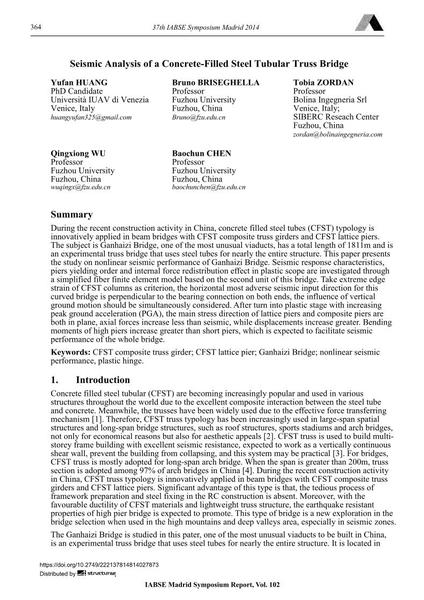Seismic AnalySseisisomf aiCc oAnncraeltye sFiislleodf SateCeloTnucbruelatreTFruilslseBdriSdtgeeel Tubular Truss Bridge

|
|
|||||||||||
Bibliografische Angaben
| Autor(en): |
Yufan Huang
Bruno Briseghella Tobia Zordan Qingxiong Wu Baochun Chen |
||||
|---|---|---|---|---|---|
| Medium: | Tagungsbeitrag | ||||
| Sprache(n): | Englisch | ||||
| Tagung: | IABSE Symposium: Engineering for Progress, Nature and People, Madrid, Spain, 3-5 September 2014 | ||||
| Veröffentlicht in: | IABSE Symposium Madrid 2014 | ||||
|
|||||
| Seite(n): | 364-371 | ||||
| Anzahl der Seiten (im PDF): | 8 | ||||
| Jahr: | 2014 | ||||
| DOI: | 10.2749/222137814814027873 | ||||
| Abstrakt: |
During the recent construction activity in China, concrete filled steel tubes (CFST) typology is innovatively applied in beam bridges with CFST composite truss girders and CFST lattice piers. The subject is Ganhaizi Bridge, one of the most unusual viaducts, has a total length of 1811m and is an experimental truss bridge that uses steel tubes for nearly the entire structure. This paper presents the study on nonlinear seismic performance of Ganhaizi Bridge. Seismic response characteristics, piers yielding order and internal force redistribution effect in plastic scope are investigated through a simplified fiber finite element model based on the second unit of this bridge. Take extreme edge strain of CFST columns as criterion, the horizontal most adverse seismic input direction for this curved bridge is perpendicular to the bearing connection on both ends, the influence of vertical ground motion should be simultaneously considered. After turn into plastic stage with increasing peak ground acceleration (PGA), the main stress direction of lattice piers and composite piers are both in plane, axial forces increase less than seismic, while displacements increase greater. Bending moments of high piers increase greater than short piers, which is expected to facilitate seismic performance of the whole bridge. |
||||
| Stichwörter: |
plastische Gelenke
|
||||
